Comparative Assessment of Priority Listing and Mixed Integer Linear Programming Unit Commitment Methods for Non-Interconnected Island Systems
Abstract
:1. Introduction
2. Unit Commitment Variants
2.1. Priority Listing UC
2.2. Deterministic MILP-Based UC
2.3. Essential Differences Between the Examined UC Approaches
3. Study-Case Systems
4. Results and Discussion
4.1. Operation of the Medium-Size Island System
4.1.1. Daily Operation without Wind Forecasting
- Scenario 1: MILP-UC without wind forecasting.
- Scenario 2: PL-UC without wind forecasting.
4.1.2. Annual Results
- Scenario 3: MILP-UC with perfect wind forecasting
- Scenario 4: PL-UC with perfect wind forecasting
4.2. Annual Operation of Large-Size Island System
5. Conclusions
Author Contributions
Funding
Acknowledgments
Conflicts of Interest
Nomenclature
| Indices | |
| t | Time interval (period) of the optimization horizon |
| u | Conventional unit |
| e | Index of reserve types {pr, sr, tr}, for primary, secondary and tertiary reserves |
| b | Index of blocks of the linearized cost function of each thermal unit |
| Continuous Variables | |
| Total production cost of all operating units | |
| Total start-up cost over the dispatch horizon | |
| Total shut-down cost over the dispatch horizon | |
| Total cost of slack variables | |
| Production level of unit u | |
| Dynamic limitation of wind power for period t | |
| Minimum loading limitation of wind power for period t | |
| Type e reserve (up/down) provided by unit u in period t | |
| Type e reserve requirements (up/down) in period t | |
| Slack variable for quantity * | |
| Production level of unit u at block b in dispatch period t | |
| Binary Variables | |
| Binary variable equal to 1 if unit u starts up at t | |
| Binary variable equal to 1 if unit u shuts down at t | |
| Binary variable equal to 1 if unit u is online at t | |
| Binary variable equal to 1 if the power output of unit u at t exceeds block b | |
| Parameters | |
| Variable operating cost of unit u at minimum loading level | |
| Start-up cost of unit u per start-up event | |
| Shut-down cost of unit u per shut-down event | |
| System frequency before disturbance | |
| System frequency after the disturbance (loss of largest unit) | |
| Total demand in period t | |
| Maximum power output of unit u in period t | |
| Minimum power output of unit u in period t | |
| Total wind production in period t | |
| Estimated wind production in period t | |
| Actual wind production in period t | |
| Type e reserves capability of unit u | |
| Ramp down rate of unit u | |
| Ramp up rate of unit u | |
| Droop characteristic of unit u | |
| Upper limit of block b of the variable cost of unit u | |
| Dynamic limitation coefficient for wind penetration in PL-UC | |
| Coefficient quantifying the proportion of wind power that may be suddenly lost | |
| Permissible frequency drop at steady state conditions, after a severe disturbance | |
| Coefficient expressing the level of load-related spinning reserves in PL-UC | |
| Penalty factor for the relaxation of constraints for quantity in MILP-UC | |
| Slope of block b of the variable cost of unit u | |
Appendix A
| Unit | Priority | Seasonal Usage | Pmax | Pmin | ru | rd | S (%) |
|---|---|---|---|---|---|---|---|
| (MW) | (MW/min) | ||||||
| 1–3 | 1–3 | – | 12.0 | 7.0 | 0.60 | 0.60 | 5% |
| 4,5 | 4,5 | – | 8.0 | 4.0 | 0.40 | 0.40 | 5% |
| 6 | 6 | – | 7.5 | 4.5 | 0.28 | 0.28 | 5% |
| 7 | 7 | – | 5.0 | 3.0 | 0.25 | 0.25 | 5% |
| 8 | 8 | – | 7.5 | 2.0 | 0.75 | 0.75 | 5% |
| 9 | 9 | – | 15.0 | 3.0 | 1.30 | 1.30 | 5% |
| 10–14 | 10–14 | ✓ | 3.0 | 1.0 | 0.15 | 0.15 | 5% |
| Unit | Fuel | Operating Point (% of Pmax) | Fuel Consumption @ Operating Point (kg/kWh) | ||||
|---|---|---|---|---|---|---|---|
| A | B | C | A | B | C | ||
| 1–3 | HFO | 63% | 83% | 100% | 0.211 | 0.198 | 0.206 |
| 4–5 | HFO | 50% | 75% | 100% | 0.220 | 0.208 | 0.225 |
| 6 | HFO | 67% | 80% | 93% | 0.235 | 0.215 | 0.220 |
| 7 | HFO | 64% | 80% | 90% | 0.205 | 0.195 | 0.201 |
| 8 | LFO | 33% | 67% | 87% | 0.360 | 0.290 | 0.315 |
| 9 | LFO | 31% | 65% | 100% | 0.400 | 0.380 | 0.410 |
| 10–14 | LFO | 50% | 73% | 93% | 0.265 | 0.260 | 0.262 |
| Unit | Priority | Seasonal Usage | Pmax | Pmin | ru | rd | S (%) |
|---|---|---|---|---|---|---|---|
| (MW) | (MW/min) | ||||||
| 1,2 | 1,2 | – | 15.0 | 10.0 | 0.75 | 0.75 | 5% |
| 3–6 | 15–18 | – | 25.0 | 4.5 | 1.25 | 1.25 | 5% |
| 7–8 | 13,14 | – | 12.0 | 5.0 | 0.60 | 0.60 | 5% |
| 9–11 | 10–12 | – | 23.0 | 14.0 | 1.15 | 1.15 | 5% |
| 12–18 | 3–9 | – | 17.0 | 6.5 | 0.85 | 0.85 | 4% |
| Unit | Fuel | Operating Point (% of Pmax) | Fuel Consumption @ Operating Point (kg/kWh) | ||||
|---|---|---|---|---|---|---|---|
| A | B | C | A | B | C | ||
| 1,2 | HFO | 70% | 85% | 100% | 0.310 | 0.308 | 0.320 |
| 3–6 | LFO | 30% | 65% | 100% | 0.400 | 0.350 | 0.360 |
| 7,8 | HFO | 50% | 75% | 100% | 0.210 | 0.205 | 0.204 |
| 9–11 | HFO | 75% | 90% | 100% | 0.215 | 0.213 | 0.214 |
| 12–18 | HFO | 45% | 75% | 100% | 0.225 | 0.215 | 0.216 |
References
- Erdinc, O.; Paterakis, N.G.; Catalão, J.P.S. Overview of insular power systems under increasing penetration of renewable energy sources: Opportunities and challenges. Renew. Sustain. Energy Rev. 2015, 52, 333–346. [Google Scholar] [CrossRef] [Green Version]
- Hatziargyriou, N.; Margaris, I.; Stavropoulou, I.; Papathanassiou, S.; Dimeas, A. Noninterconnected Island Systems: The Greek Case. IEEE Electrif. Mag. 2017, 5, 17–27. [Google Scholar] [CrossRef]
- Egido, I.; Fernandez-Bernal, F.; Centeno, P.; Rouco, L. Maximum frequency deviation calculation in small isolated power systems. IEEE Trans. Power Syst. 2009, 24, 1731–1738. [Google Scholar] [CrossRef]
- Delille, G.; François, B.; Malarange, G. Dynamic Frequency Control Support by Energy Storage to Reduce the Impact of Wind and Solar Generation on Isolated Power System’s Inertia. IEEE Trans. Sustain. Energy 2012, 3, 931–939. [Google Scholar] [CrossRef]
- Papathanassiou, S.A.; Boulaxis, N.G. Power limitations and energy yield evaluation for wind farms operating in island systems. Renew. Energy 2006, 31, 457–479. [Google Scholar] [CrossRef]
- Karamanou, E.; Papathanassiou, S.; Boulaxis, N. Operating policies for autonomous Island grids with PV penetration. In Proceedings of the 4th European PV-Hybrid and Mini-Grid Conference, Athens, Greece, 29–30 May 2008. [Google Scholar]
- Psarros, G.N.; Karamanou, E.G.; Papathanassiou, S.A. Feasibility Analysis of Centralized Storage Facilities in Isolated Grids. IEEE Trans. Sustain. Energy 2018, 9, 1822–1832. [Google Scholar] [CrossRef]
- Psarros, G.N.; Kokkolios, S.P.; Papathanassiou, S.A. Centrally Managed Storage Facilities in Small Non-Interconnected Island Systems. In Proceedings of the 2018 53rd International Universities Power Engineering Conference (UPEC), Glasgow, UK, 4–7 September 2018. [Google Scholar]
- Brown, P.D.; Pecas Lopes, J.A.; Matos, M.A. Optimization of Pumped Storage Capacity in an Isolated Power System With Large Renewable Penetration. IEEE Trans. Power Syst. 2008, 23, 523–531. [Google Scholar] [CrossRef] [Green Version]
- Vasconcelos, H.; Moreira, C.; Madureira, A.; Lopes, J.P.; Miranda, V. Advanced Control Solutions for Operating Isolated Power Systems: Examining the Portuguese islands. IEEE Electrif. Mag. 2015, 3, 25–35. [Google Scholar] [CrossRef]
- Bakirtzis, A.G.; Dokopoulos, P.S. Short term generation scheduling in a small autonomous system with unconventional energy sources. IEEE Trans. Power Syst. 1988, 3, 1230–1236. [Google Scholar] [CrossRef]
- Contaxis, G.C.; Kabouris, J. Short term scheduling in a wind/diesel autonomous energy system. IEEE Trans. Power Syst. 1991, 6, 1161–1167. [Google Scholar] [CrossRef]
- Papaefthymiou, S.V.; Karamanou, E.G.; Papathanassiou, S.A.; Papadopoulos, M.P. A wind-hydro-pumped storage station leading to high RES penetration in the autonomous island system of Ikaria. IEEE Trans. Sustain. Energy 2010, 1, 163–172. [Google Scholar] [CrossRef]
- Lujano-Rojas, J.M.; Osório, G.J.; Catalão, J.P.S. New probabilistic method for solving economic dispatch and unit commitment problems incorporating uncertainty due to renewable energy integration. Int. J. Electr. Power Energy Syst. 2016, 78, 61–71. [Google Scholar] [CrossRef]
- Kazemi, M.; Siano, P.; Sarno, D.; Goudarzi, A. Evaluating the impact of sub-hourly unit commitment method on spinning reserve in presence of intermittent generators. Energy 2016, 113, 338–354. [Google Scholar] [CrossRef]
- Papathanassiou, S.; Papalexopoulos, A.D.; Andrianesis, P. Energy Control Centers and Electricity Markets in the Greek Non-Interconnected Islands. In Proceedings of the MedPower 2014, Athens, Greece, 2–5 November 2014; p. 46. [Google Scholar]
- Catalão, J.P.S. Electric Power Systems: Advanced Forecasting Techniques and Optimal Generation Scheduling; CRC Press: Boca Raton, FL, USA, 2012; ISBN 978-1-4398-9396-8. [Google Scholar]
- Frangioni, A.; Gentile, C.; Lacalandra, F. Tighter Approximated MILP Formulations for Unit Commitment Problems. IEEE Trans. Power Syst. 2009, 24, 105–113. [Google Scholar] [CrossRef] [Green Version]
- Padhy, N.P. Unit Commitment—A Bibliographical Survey. IEEE Trans. Power Syst. 2004, 19, 1196–1205. [Google Scholar] [CrossRef]
- Morales-Espana, G.; Latorre, J.M.; Ramos, A. Tight and Compact MILP Formulation for the Thermal Unit Commitment Problem. IEEE Trans. Power Syst. 2013, 28, 4897–4908. [Google Scholar] [CrossRef]
- Morales-Espana, G.; Latorre, J.M.; Ramos, A. Tight and Compact MILP Formulation of Start-Up and Shut-Down Ramping in Unit Commitment. IEEE Trans. Power Syst. 2013, 28, 1288–1296. [Google Scholar] [CrossRef]
- Simoglou, C.K.; Kardakos, E.G.; Bakirtzis, E.A.; Chatzigiannis, D.I.; Vagropoulos, S.I.; Ntomaris, A.V.; Biskas, P.N.; Gigantidou, A.; Thalassinakis, E.J.; Bakirtzis, A.G.; et al. An advanced model for the efficient and reliable short-term operation of insular electricity networks with high renewable energy sources penetration. Renew. Sustain. Energy Rev. 2014, 38, 415–427. [Google Scholar] [CrossRef]
- Chang, G.W.; Chuang, C.S.; Lu, T.K.; Wu, C.C. Frequency-regulating reserve constrained unit commitment for an isolated power system. IEEE Trans. Power Syst. 2013, 28, 578–586. [Google Scholar] [CrossRef]
- Sokoler, L.E.; Vinter, P.; Baerentsen, R.; Edlund, K.; Jorgensen, J.B. Contingency-Constrained Unit Commitment in Meshed Isolated Power Systems. IEEE Trans. Power Syst. 2016, 31, 3516–3526. [Google Scholar] [CrossRef]
- Simoglou, C.K.; Bakirtzis, E.A.; Biskas, P.N.; Bakirtzis, A.G. Optimal operation of insular electricity grids under high RES penetration. Renew. Energy 2016, 86, 1308–1316. [Google Scholar] [CrossRef]
- Asensio, M.; Contreras, J. Stochastic Unit Commitment in Isolated Systems With Renewable Penetration Under CVaR Assessment. IEEE Trans. Smart Grid 2016, 7, 1356–1367. [Google Scholar] [CrossRef]
- Ntomaris, A.V.; Bakirtzis, E.A.; Chatzigiannis, D.I.; Simoglou, C.K.; Biskas, P.N.; Bakirtzis, A.G. Reserve Quantification in Insular Power Systems with High Wind Penetration. In Proceedings of the IEEE PES Innovative Smart Grid Technologies, Europe, Istanbul, Turkey, 12–15 October 2014; pp. 1–6. [Google Scholar]
- Tian, Y.; Fan, L.; Tang, Y.; Wang, K.; Li, G.; Wang, H. A Coordinated Multi-Time Scale Robust Scheduling Framework for Isolated Power System With ESU Under High RES Penetration. IEEE Access 2018, 6, 9774–9784. [Google Scholar] [CrossRef]
- Psarros, G.N.; Nanou, S.I.; Papaefthymiou, S.V.; Papathanassiou, S.A. Generation scheduling in non-interconnected islands with high RES penetration. Renew. Energy 2018, 115, 338–352. [Google Scholar] [CrossRef]
- Psarros, G.N.; Papathanassiou, S.A. Bi-level Minimum Loading Unit Commitment for Small Isolated Power Systems. In Proceedings of the MedPower 2018, Dubrovnik, Croatia, 12–15 November 2018. [Google Scholar]
- Psarros, G.N.; Papathanassiou, S.A. Comparative Assessment of Unit Commitment Methods for Isolated Island Grids. In Proceedings of the 2018 53rd International Universities Power Engineering Conference (UPEC), Glasgow, UK, 4–7 September 2018. [Google Scholar]
- Caralis, G.; Christakopoulos, T.; Karellas, S.; Gao, Z. Analysis of energy storage systems to exploit wind energy curtailment in Crete. Renew. Sustain. Energy Rev. 2019, 103, 122–139. [Google Scholar] [CrossRef]
- Kundur, P.; Paserba, J.; Ajjarapu, V.; Andersson, G.; Bose, A.; Van Cutsem, T.; Canizares, C.; Hatziargyriou, N.; Hill, D.; Vittal, V.; et al. Definition and Classification of Power System Stability IEEE/CIGRE Joint Task Force on Stability Terms and Definitions. IEEE Trans. Power Syst. 2004, 19, 1387–1401. [Google Scholar] [CrossRef]
- Arroyo, J.M.; Conejo, A.J. Optimal response of a thermal unit to an electricity spot market. IEEE Trans. Power Syst. 2000, 15, 1098–1104. [Google Scholar] [CrossRef]
- Carrion, M.; Arroyo, J.M. A Computationally Efficient Mixed-Integer Linear Formulation for the Thermal Unit Commitment Problem. IEEE Trans. Power Syst. 2006, 21, 1371–1378. [Google Scholar] [CrossRef]
- Wood, A.; Wollenberg, B.; Shebleeacute, G. Power Generation, Operation and Control, 3rd ed.; Wiley: Hoboken, NJ, USA, 2013; ISBN 9780471790556. [Google Scholar]
- Shahidehpour, M.; Yamin, H.; Li, Z. Market Operations in Electric Power Systems: Forecasting, Scheduling, and Risk Management; Wiley: Hoboken, NJ, USA, 2009; ISBN 9781424442416. [Google Scholar]
- General Algebraic Modeling System (GAMS). Available online: https://www.gams.com/ (accessed on 19 December 2016).
- IBM CPLEX Optimizer. Available online: https://www-01.ibm.com/software/commerce/optimization/cplex-optimizer/ (accessed on 19 December 2016).
- Thomas, D.; Deblecker, O.; Ioakimidis, C.S. Optimal design and techno-economic analysis of an autonomous small isolated microgrid aiming at high RES penetration. Energy 2016, 116, 364–379. [Google Scholar] [CrossRef]
- Miranda, I.; Silva, N.; Leite, H. A Holistic Approach to the Integration of Battery Energy Storage Systems in Island Electric Grids with High Wind Penetration. IEEE Trans. Sustain. Energy 2016, 7, 775–785. [Google Scholar] [CrossRef]
- Kuo, M.; Lu, S.-D.; Tsou, M.-C. Considering Carbon Emissions in Economic Dispatch Planning for Isolated Power Systems: A Case Study of the Taiwan Power System. IEEE Trans. Ind. Appl. 2018, 54, 987–997. [Google Scholar] [CrossRef]
- Solanki, B.V.; Bhattacharya, K.; Canizares, C.A. A Sustainable Energy Management System for Isolated Microgrids. IEEE Trans. Sustain. Energy 2017, 8, 1507–1517. [Google Scholar] [CrossRef]
- Andersson, G. Dynamics and Control of Electric Power Systems; EEH-Power Systems Laboratory ETH: Zurich, Switzerland, 2012. [Google Scholar]
- Lee, Y.; Baldick, R. A Frequency-Constrained Stochastic Economic Dispatch Model. IEEE Trans. Power Syst. 2013, 28, 2301–2312. [Google Scholar] [CrossRef]
- Ahmadi, H.; Ghasemi, H. Security-constrained unit commitment with linearized system frequency limit constraints. IEEE Trans. Power Syst. 2014, 29, 1536–1545. [Google Scholar] [CrossRef]
- Wen, Y.; Li, W.; Huang, G.; Liu, X. Frequency Dynamics Constrained Unit Commitment With Battery Energy Storage. IEEE Trans. Power Syst. 2016, 31, 5115–5125. [Google Scholar] [CrossRef]
- Hansen, C.W.; Papalexopoulos, A.D. Operational Impact and Cost Analysis of Increasing Wind Generation in the Island of Crete. IEEE Syst. J. 2012, 6, 287–295. [Google Scholar] [CrossRef]
- Dokopoulos, P.S.; Saramourtsis, A.C.; Bakirtzis, A.G. Prediction and evaluation of the performance of wind-diesel energy systems. IEEE Trans. Energy Convers. 1996, 11, 385–393. [Google Scholar] [CrossRef]
- Andrianesis, P.; Liberopoulos, G.; Varnavas, C. The impact of wind generation on isolated power systems: The case of Cyprus. In Proceedings of the 2013 IEEE Grenoble Conference, Grenoble, France, 16–20 June 2013; pp. 1–6. [Google Scholar]
- Papalexopoulos, A.; Vitellas, I.; Hatziargyriou, N.D.; Hansen, C.; Patsaka, T.; Dimeas, A.L. Assessment and economic analysis of wind generation on the ancillary services and the unit commitment process for an isolated system. In Proceedings of the 2011 16th International Conference on Intelligent System Applications to Power Systems, Hersonissos, Greece, 25–28 September 2011; pp. 1–6. [Google Scholar]
- Kundur, P. Power System Stability and Control, 1st ed.; McGraw-Hill Education: New York, NY, USA, 1994; ISBN 978-0070359581. [Google Scholar]
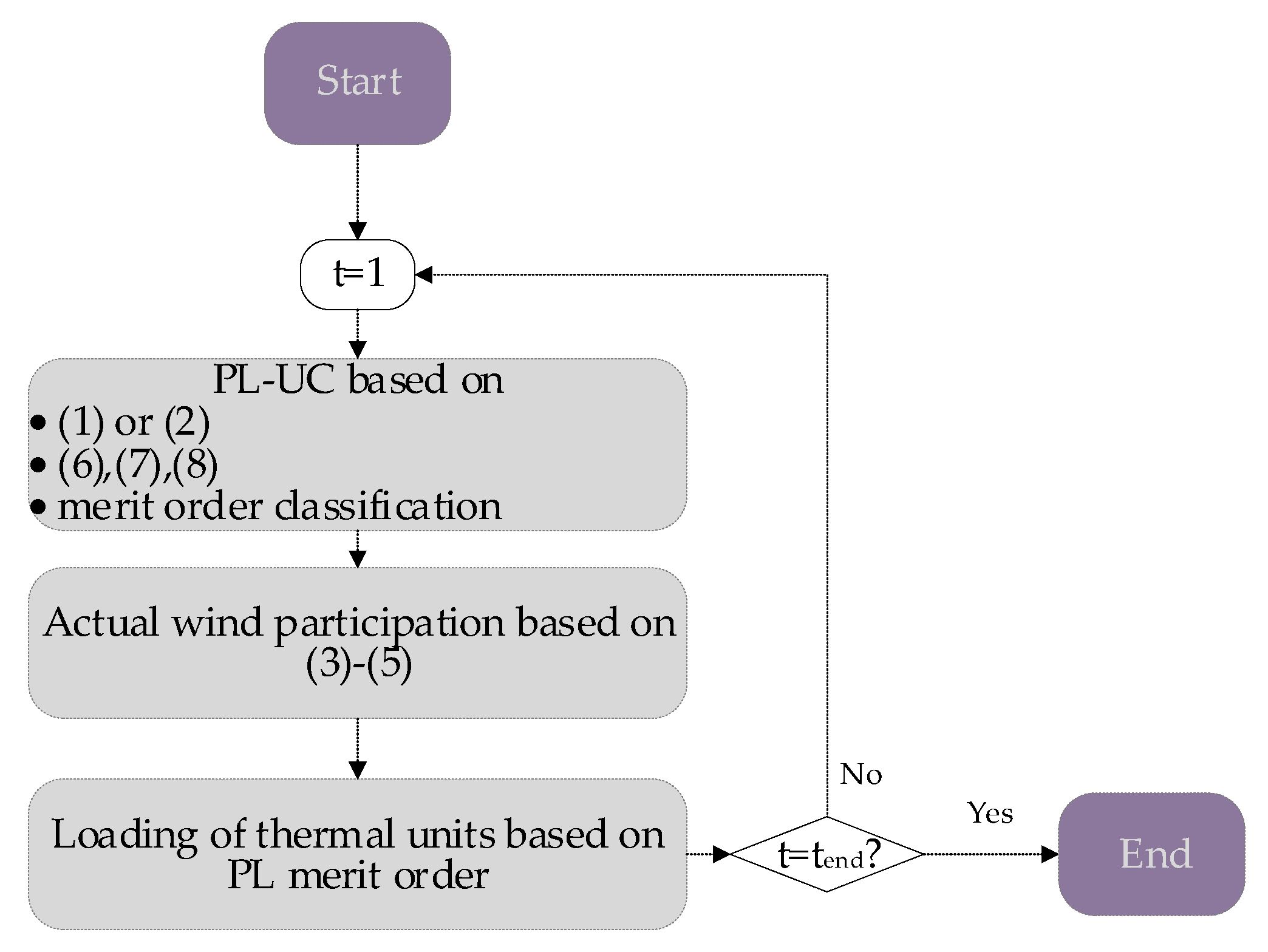



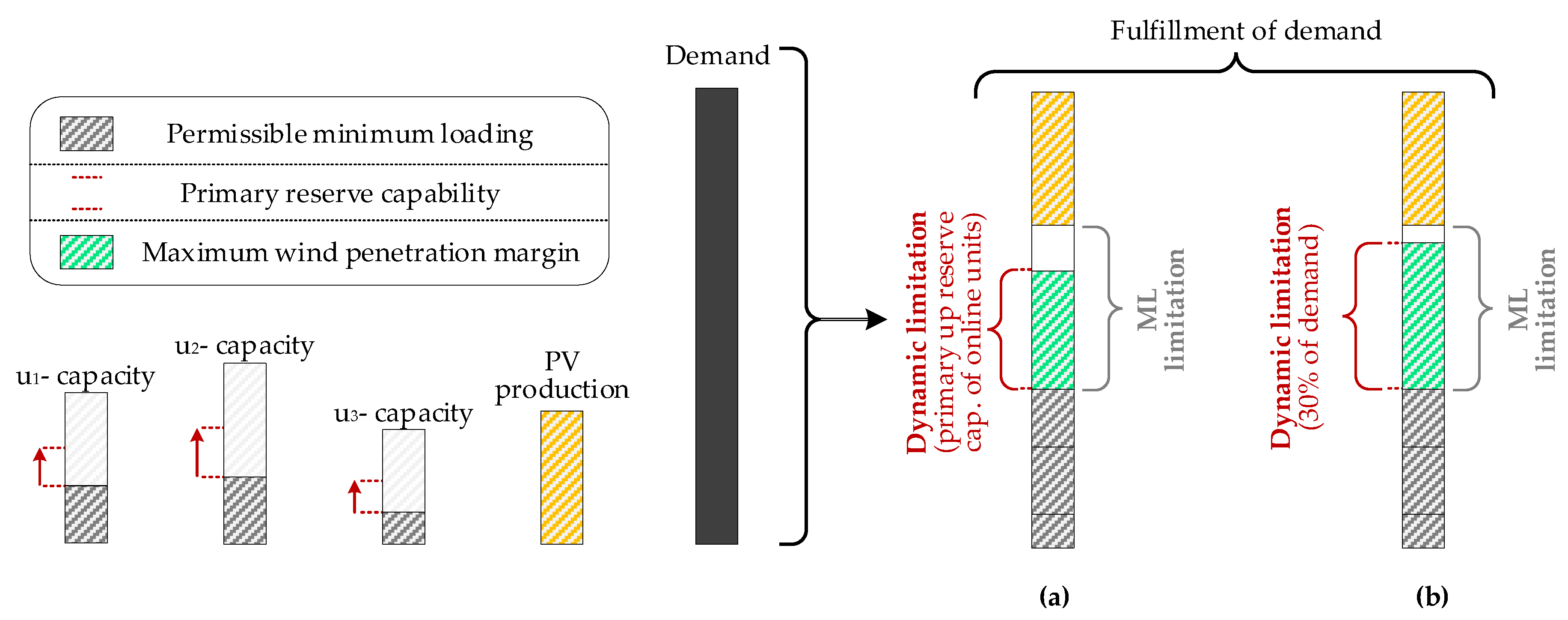



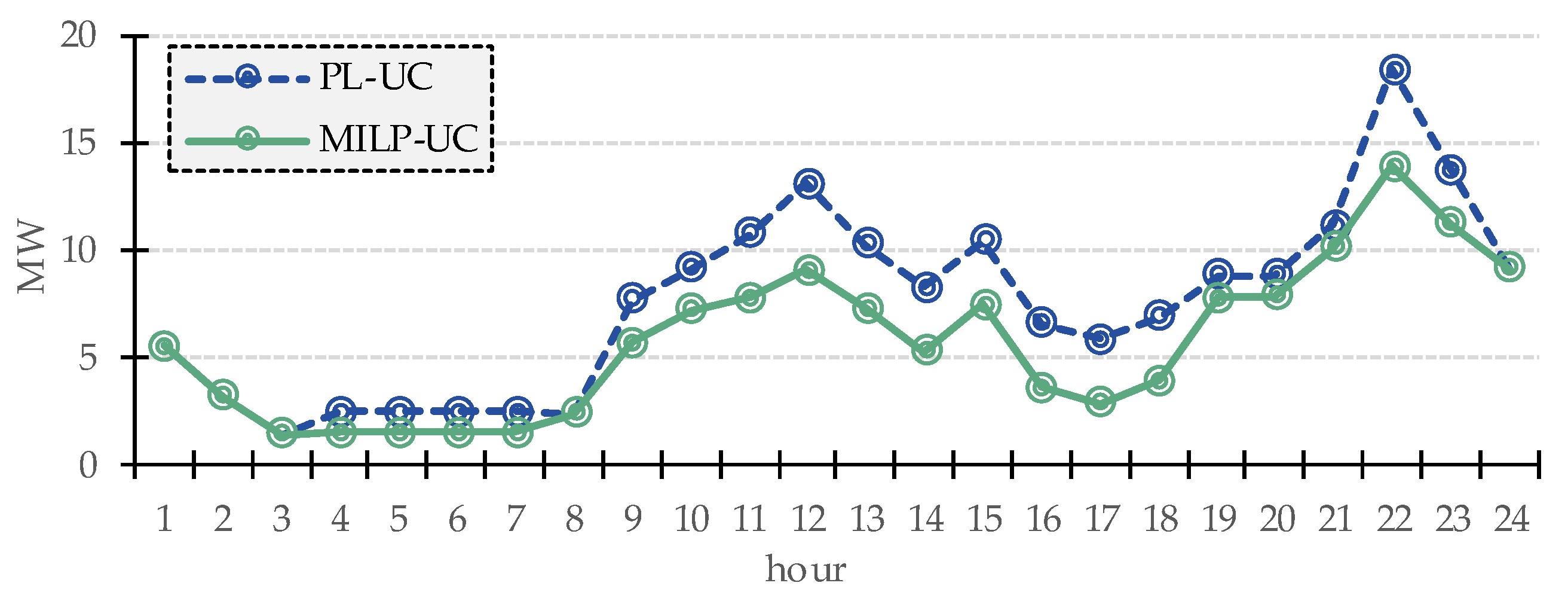
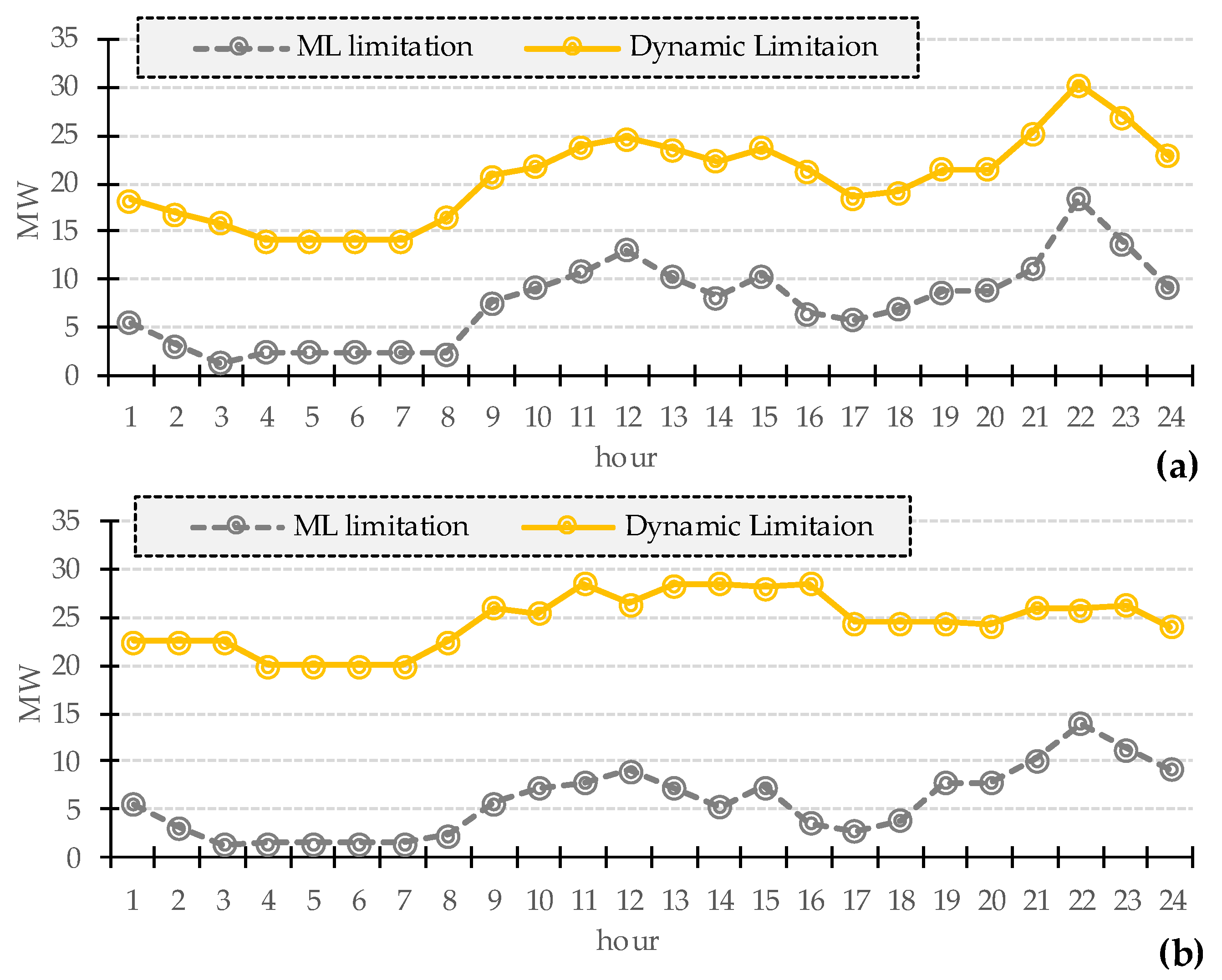
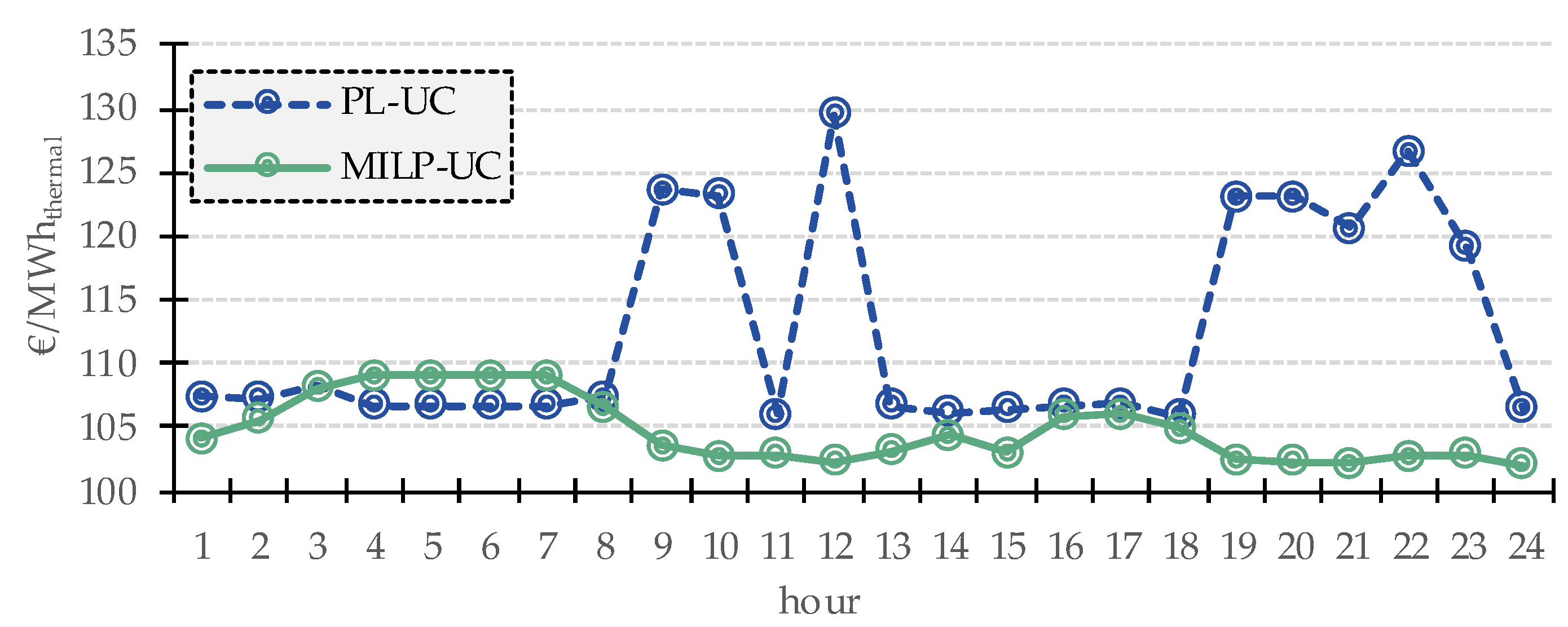

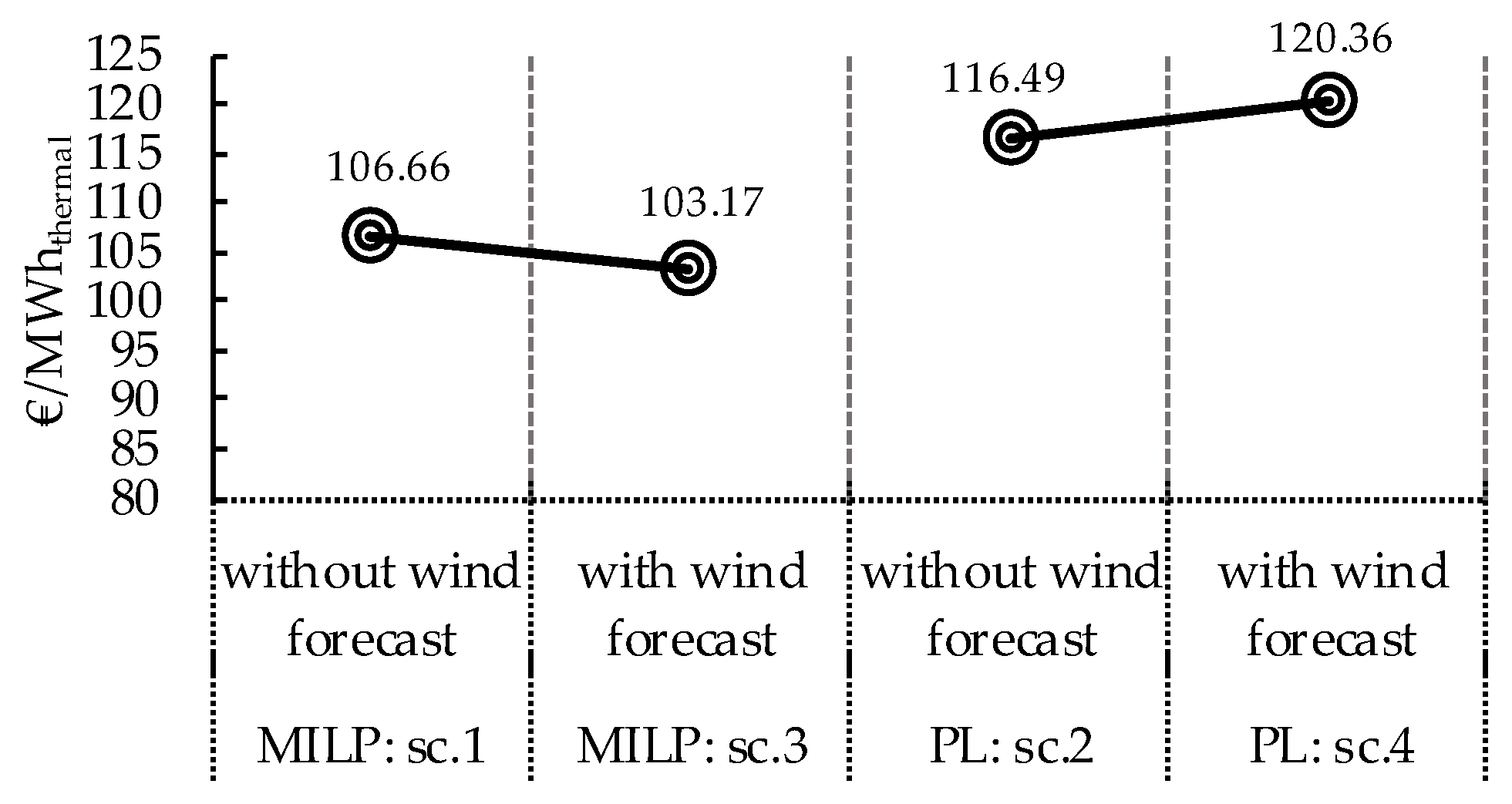
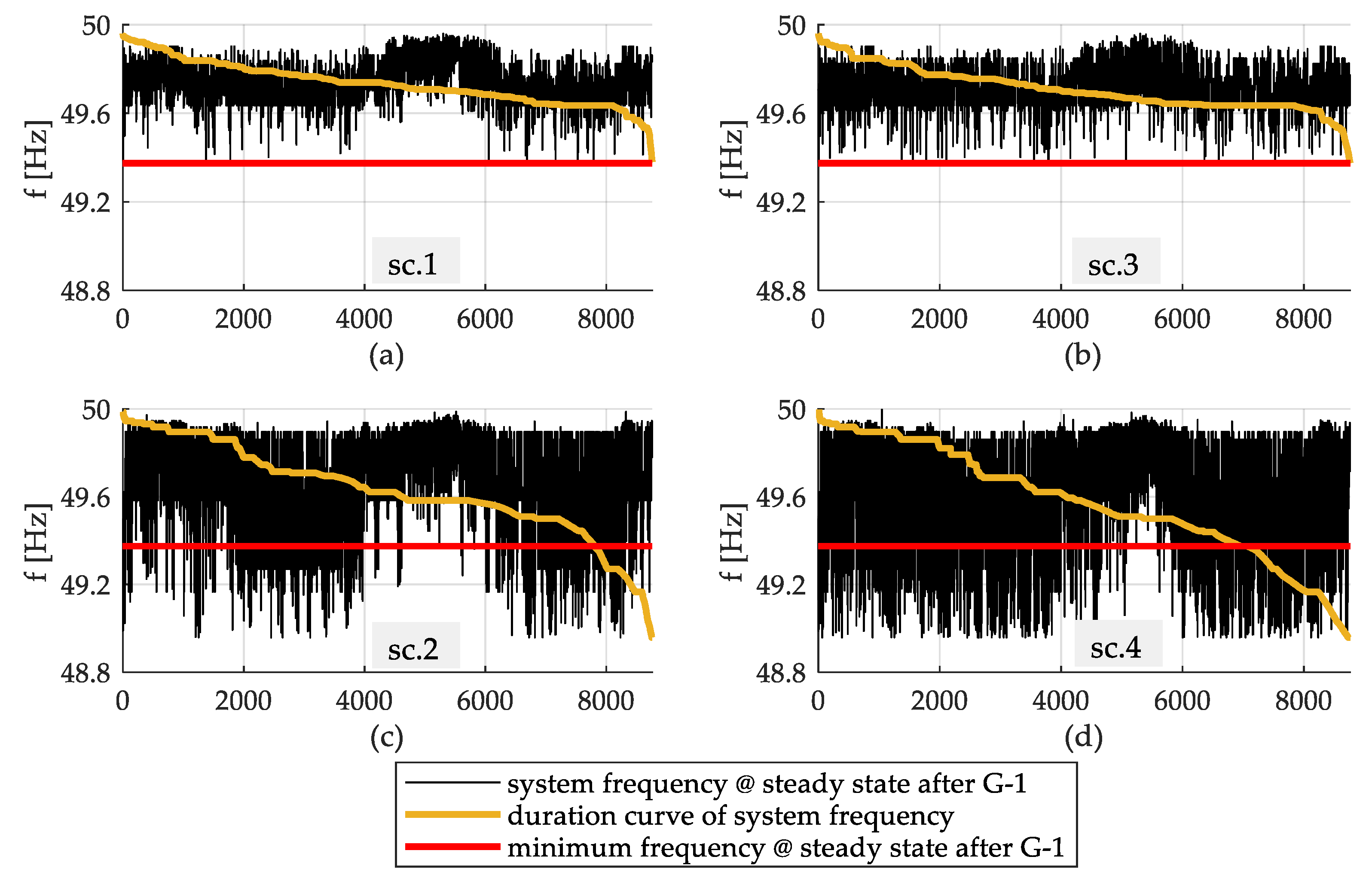

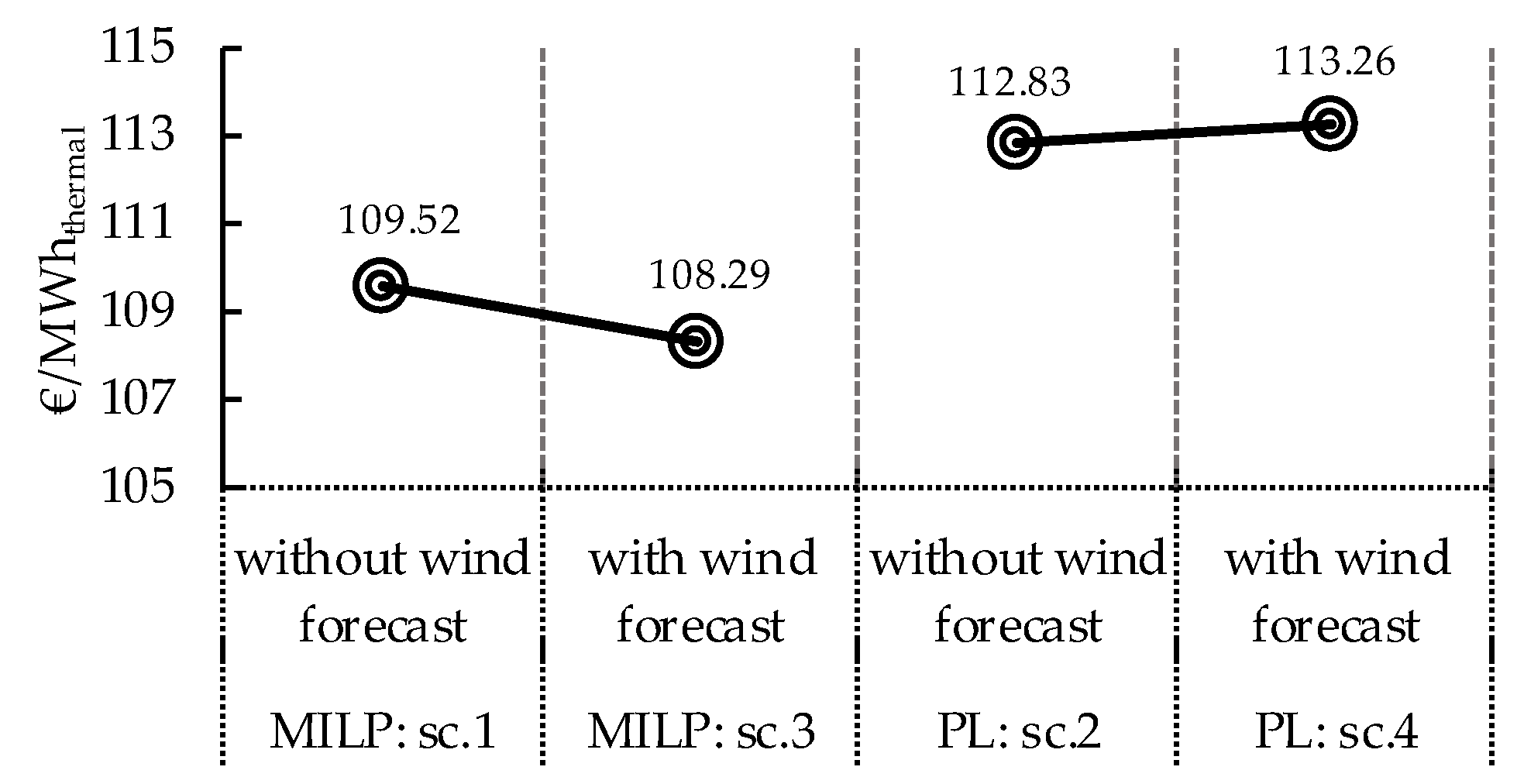
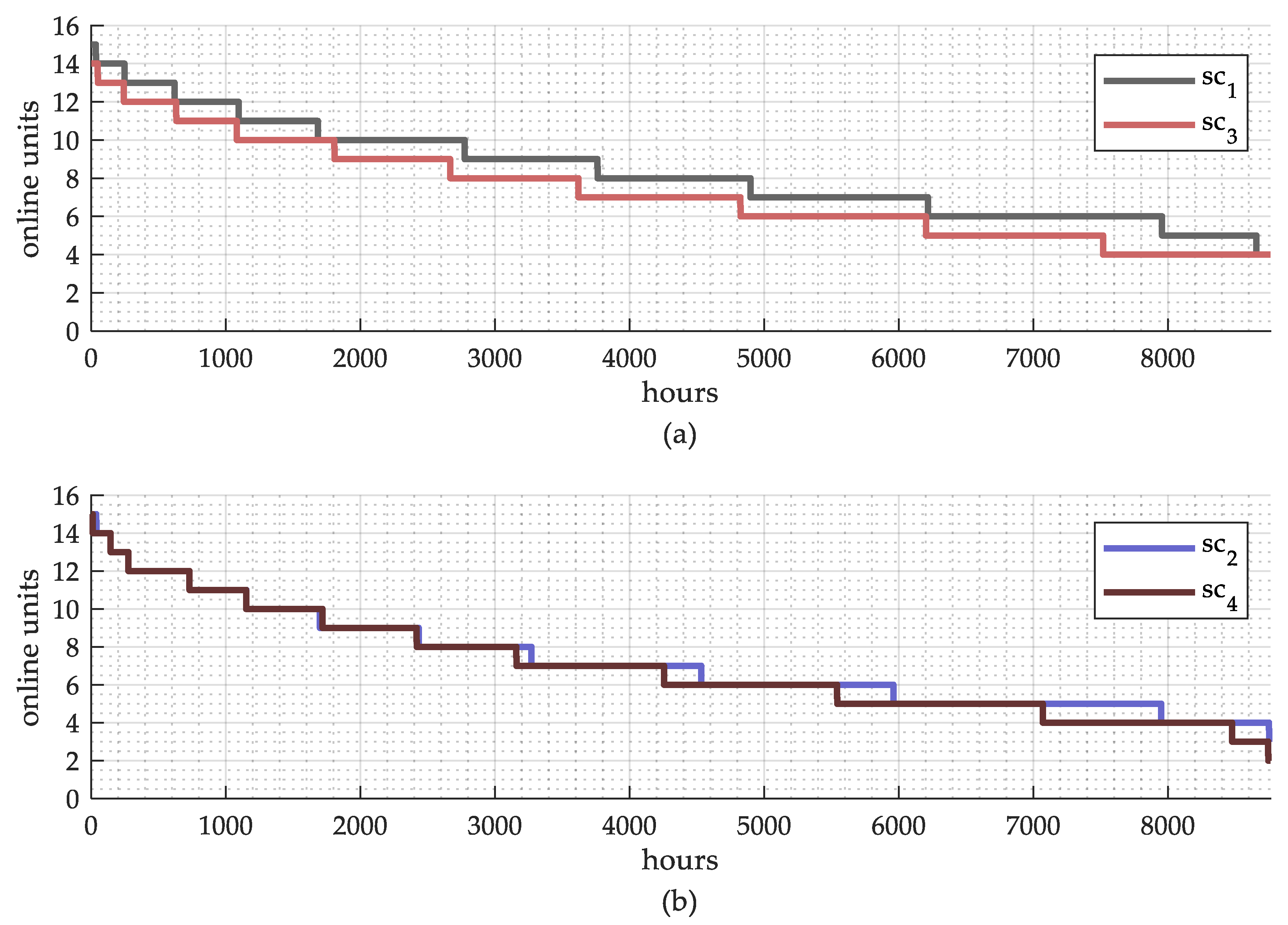

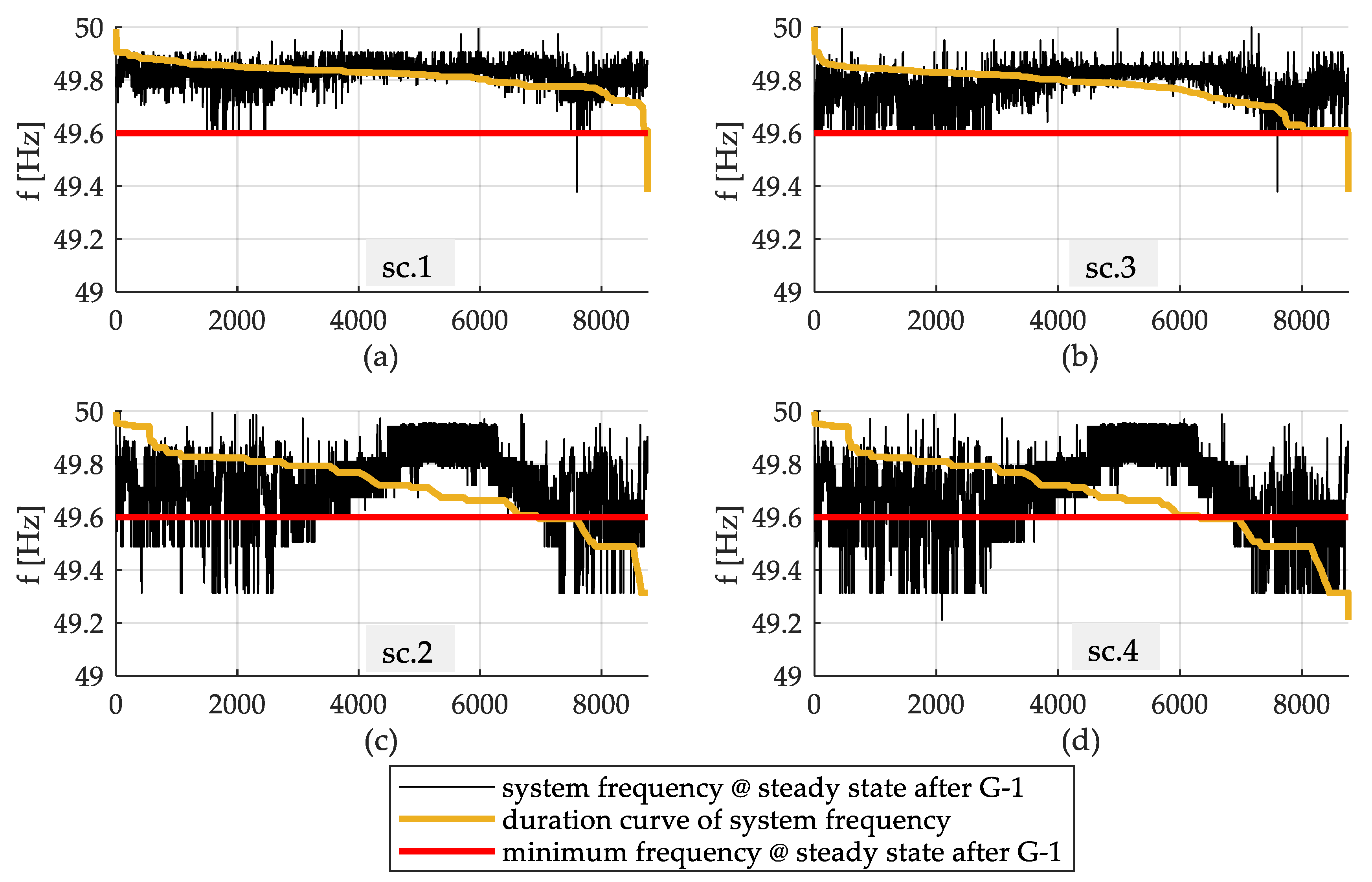
| h/u | u1 | u2 | u3 | u4 | u5 | u6 | u7 | u8 | u9 | Net Load (MW) |
|---|---|---|---|---|---|---|---|---|---|---|
| 1 | ○ ● | ○ - | ○ ● | ○ ● | - ● | - - | - ● | - - | - - | 31 |
| 2 | ○ ● | ○ - | ○ ● | ○ ● | - ● | - - | - ● | - - | - - | 28 |
| 3 | ○ ● | ○ - | ○ ● | ○ ● | - ● | - - | - ● | - - | - - | 26 |
| 4 | ○ ● | ○ - | ○ ● | - ● | - ● | - - | - - | - - | - - | 23 |
| 5 | ○ ● | ○ - | ○ ● | - ● | - ● | - - | - - | - - | - - | 23 |
| 6 | ○ ● | ○ - | ○ ● | - ● | - ● | - - | - - | - - | - - | 23 |
| 7 | ○ ● | ○ - | ○ ● | - ● | - ● | - - | - - | - - | - - | 23 |
| 8 | ○ ● | ○ - | ○ ● | ○ ● | - ● | - - | - ● | - - | - - | 28 |
| 9 | ○ ● | ○ ● | ○ ● | ○ ● | - ● | - - | - - | ○ - | - - | 34 |
| 10 | ○ ● | ○ ● | ○ ● | ○ ● | - ● | - - | - - | ○ - | - - | 36 |
| 11 | ○ ● | ○ ● | ○ ● | ○ ● | ○ ● | - - | - ● | - - | - - | 40 |
| 12 | ○ ● | ○ ● | ○ ● | ○ ● | - ● | - - | - ● | - - | ○ - | 41 |
| 13 | ○ ● | ○ ● | ○ ● | ○ ● | ○ ● | - - | - ● | - - | - - | 39 |
| 14 | ○ ● | ○ ● | ○ ● | ○ ● | ○ ● | - - | - ● | - - | - - | 38 |
| 15 | ○ ● | ○ ● | ○ ● | ○ ● | ○ ● | - - | - ● | - - | - - | 39 |
| 16 | ○ ● | ○ ● | ○ ● | ○ ● | ○ ● | - - | - ● | - - | - - | 35 |
| 17 | ○ ● | ○ ● | ○ ● | ○ - | - ● | - - | - ● | - - | - - | 31 |
| 18 | ○ ● | ○ ● | ○ ● | ○ - | - ● | - - | - ● | - - | - - | 32 |
| 19 | ○ ● | ○ ● | ○ ● | ○ - | - ● | - - | - ● | ○ - | - - | 36 |
| 20 | ○ ● | ○ ● | ○ ● | ○ - | - ● | - - | - ● | ○ - | - - | 36 |
| 21 | ○ ● | ○ ● | ○ ● | ○ ● | ○ ● | - - | - ● | ○ - | - - | 42 |
| 22 | ○ ● | ○ ● | ○ ● | ○ ● | ○ ● | - ● | - ● | - - | ○ - | 50 |
| 23 | ○ ● | ○ ● | ○ ● | ○ ● | ○ ● | - ● | - - | ○ - | - - | 45 |
| 24 | ○ ● | ○ ● | ○ ● | ○ ● | ○ ● | - - | - - | - - | - - | 38 |
| Scenario | 1 | 2 | 3 | 4 |
|---|---|---|---|---|
| UC variant | MILP | PL | MILP | PL |
| Minimum loading limitation (h) | 7914 | 8760 | 4082 | 8760 |
| Dynamic limitation (h) | 846 | 0 | 4678 | 0 |
© 2019 by the authors. Licensee MDPI, Basel, Switzerland. This article is an open access article distributed under the terms and conditions of the Creative Commons Attribution (CC BY) license (http://creativecommons.org/licenses/by/4.0/).
Share and Cite
Psarros, G.N.; Papathanassiou, S.A. Comparative Assessment of Priority Listing and Mixed Integer Linear Programming Unit Commitment Methods for Non-Interconnected Island Systems. Energies 2019, 12, 657. https://doi.org/10.3390/en12040657
Psarros GN, Papathanassiou SA. Comparative Assessment of Priority Listing and Mixed Integer Linear Programming Unit Commitment Methods for Non-Interconnected Island Systems. Energies. 2019; 12(4):657. https://doi.org/10.3390/en12040657
Chicago/Turabian StylePsarros, Georgios N., and Stavros A. Papathanassiou. 2019. "Comparative Assessment of Priority Listing and Mixed Integer Linear Programming Unit Commitment Methods for Non-Interconnected Island Systems" Energies 12, no. 4: 657. https://doi.org/10.3390/en12040657





